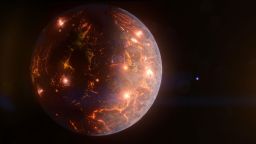Story highlights
An exoplanet like Vulcan from "Star Trek" has been found orbiting a star 16 light-years from Earth
The creator of "Star Trek" selected this star as the host for Vulcan in 1991
Maybe the final frontier isn’t so far out of reach. Astronomers have found an exoplanet reminiscent of the planet Vulcan from “Star Trek,” orbiting a star in a system only 16 light-years from Earth.
The discovery, detailed in a study published this week in the Monthly Notice of the Royal Astronomical Society, is the first super-Earth detected by the Dharma Planet Survey and Dharma Endowment Foundation Telescope. The 50-inch telescope is on top of Mt. Lemmon in southern Arizona.
It’s “the closest super-Earth orbiting another Sun-like star,” said Jian Ge, study author and astronomer from the University of Florida, in a statement.
Super-Earths have a mass greater than Earth’s but aren’t as big as other giant, gaseous planets.
“The planet is roughly twice the size of Earth and orbits its star with a 42-day period just inside the star’s optimal habitable zone,” Ge said. When a planet is within the habitable zone of its star, that means liquid water could pool on its surface – which could support life as we know it.
It orbits an orange-tinted star named HD 26965, which is only slightly cooler and little less massive than our own sun. It is comparable in age to our sun, and it has a similar magnetic cycle, according to Tennessee State University astronomer and study author Matthew Muterspaugh.
“Therefore,” he said, “HD 26965 may be an ideal host star for an advanced civilization.” And live long and prosper.
But “Star Trek” fans may know the star by another name: 40 Eridani A. This very real star was confirmed by “Star Trek” creator Gene Roddenberry himself as the host star for the fictional planet of Vulcan, the home world of science officer Spock, played by Leonard Nimoy on the original television show.
In July 1991, Roddenberry, along with astronomers from the Harvard-Smithsonian Center for Astrophysics, wrote in a “letter to the editor” published in Sky and Telescope that 40 Eridani A would be the ideal star to host Vulcan.
“Presumably Vulcan orbits the primary star, an orange main-sequence dwarf of spectral type K1. … Two companion stars – a 9th magnitude white dwarf and an 11th magnitude red dwarf – orbit each other about 400 astronomical units from the primary. They would gleam brilliantly in the Vulcan sky,” they wrote.
And now, a planet has been found right where Roddenberry and astronomers Sallie Baliunas, Robert Donahue and George Nassiopoulos thought Vulcan would be.
The researchers also pointed out that 40 Eridani A, in the Eridanus constellation, is visible in the night sky with the naked eye – not something that can be said for most host stars of exoplanets.
The goal of the Dharma Planet Survey is much like the crew of the starship Enterprise, the researchers said.
“Spock served on the starship Enterprise, whose mission was to seek out strange new worlds, a mission shared by the Dharma Planet Survey,” said Gregory Henry, study author and Tennessee State University astronomer.
And the astronomers involved in this discovery hope it is only the beginning.
“This discovery demonstrates that fully dedicated telescopes conducting high-cadence, high-precision radial velocity observations in the near future will continue to play a key role in the discovery of more super-Earths and even Earth-like planets in the habitable zones around nearby stars,” Ge said.






